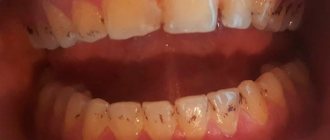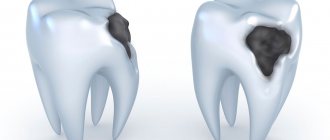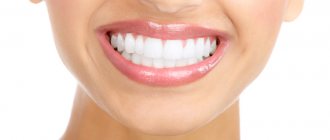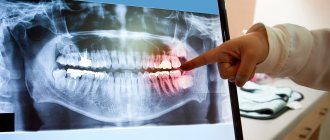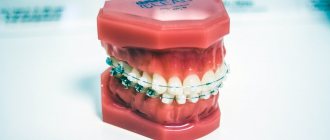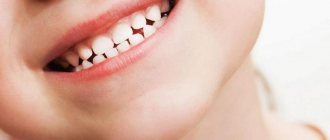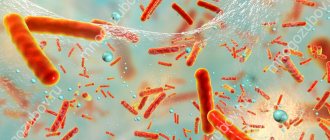Rotten, caries-affected and weakened teeth are not only an aesthetic problem.
Often they become the cause or consequence of serious diseases of internal organs and systems, leading to a decrease in their function and pathological changes. The psychological state of the patient also changes, discomfort appears when smiling, and bad breath appears.
There is a whole scheme that determines the relationship between diseased teeth and vital organs. Untreated caries almost always leads to serious heart and joint diseases, liver or intestinal dysfunction.
The problem occurs not only in adults; caries can affect barely erupted teeth in infants.
Bad teeth in a child: reasons
A child’s baby teeth rot for various reasons.
Some are impossible to influence, others can be easily eliminated by dentists and caring adults. Most often, destruction of the enamel, and subsequently the coronal part of the primary occlusion units, is facilitated by:
- Disorders of intrauterine development of a child. Developmental pathologies are formed due to maternal toxicosis, non-compliance with nutritional recommendations, and the use of potent medications.
- Early birth of the baby. Prematurity of a baby indicates incomplete formation of internal systems - in particular, weak thin enamel of baby teeth.
- Antibacterial therapy administered to a child in the first year of life.
- Poor hygiene. Lack of systematic cleaning after the first tooth erupts, improper care, and inadequate parental control.
- Unbalanced child nutrition. Predominance of flour and sweets in the menu, lack of fermented milk and dairy products, hard fruits and vegetables.
- Reduced immunity. Congenital or due to a lack of vitamins in the diet.
- Diseases of the gastrointestinal tract, dysbacteriosis.
- Diseases of the endocrine system - diabetes mellitus.
- Previous infections - ARVI, chicken pox, scarlet fever.
- Pathogenic microflora entering the baby’s mouth from the outside. If family members have the habit of licking the baby’s spoon or pacifier, or kissing the baby on the lips.
- Poor ecology is a significant external factor that negatively affects the condition of the child’s teeth and general well-being.
- Heredity - parents or grandparents have bad teeth.
- Mechanical injuries, external damage to tooth enamel - cracks, small chips.
How to determine if a child has bad baby teeth
A child's rotten front teeth are immediately visible. These are dark or yellow spots of enamel, reddened gums, and damaged edges. But sometimes decay begins on the distant teeth - molars, premolars, and then you need to focus on indirect signs.
The fact that a child is growing bad teeth is indicated by:
- complaints of pain and discomfort - reaction to toothpaste, hot or cold foods;
- unpleasant odor from the baby’s mouth - putrid, pungent;
- change in enamel color - the appearance of dark stripes, yellow or dark spots;
- development of dental diseases - caries, pulpitis.
Any of the listed factors indicates the need for consultation with a pediatric dentist - a full diagnosis and timely treatment.
Consequences for the body
In addition to exclusively external troubles (repulsive appearance, unpleasant smell), which affect a person’s psychological state, it should be taken into account that tooth decay can negatively affect the body as a whole.
Doctors even trace the relationship of this disease with the unsatisfactory condition of the entire skeletal system. This can subsequently cause arthrosis and polyarthritis .
Pathogenic microbes, which invariably accompany decay, are spread by blood and saliva throughout the body. As a result, internal organs are affected or begin to malfunction, which at first glance are completely unrelated to the infection in the mouth. There is also a possibility that decay will spread to the bone that forms the jaw, and then the brain may also be affected.
Stages of decay of children's milk teeth
A child’s bad teeth almost always mean caries. The disease is distinguished by the type and depth of tissue damage. Dentists highlight:
- Initial and superficial caries is the primary destruction of the enamel, manifested as white spots.
- Visible carious lesions are medium and deep caries. Teeth rot quickly and stains develop into cavities. The child begins to experience pain. An unpleasant odor appears from the mouth.
- Circular caries is the circular destruction of enamel and dentin near the gums. If left untreated, the tooth breaks and rots further to the root.
In particularly advanced situations, damage covers an increasingly larger volume of tissue, leading to serious pain and loss of the milk unit.
Bad teeth in a child: how to treat
Decay of baby teeth can be stopped. Especially if the parents quickly assessed the threat and brought the child to the children's dental clinic. Treatment options are different:
Remineralization of tooth enamel
The doctor will apply a special gel to the baby teeth, which contains minerals to strengthen the teeth. Usually it is calcium, phosphorus, fluorine. The substances will restore the enamel structure at an early stage of destruction, but if the teeth are already rotting, the dentist will select a different treatment.
Sealing
Cleaning out carious cavities and then installing a filling. The preparation method is selected according to the patient’s age. Modern dental clinics treat teeth without a drill - using the ICON method, as well as using classical methods.
Ozonation of teeth
A method of disinfecting destroyed cavities followed by filling, when ozone is used to eliminate pathogenic microflora. The treatment has proven itself to work with children's rotten teeth, but is only suitable for moderate decay.
Laser therapy
The disinfectant effect of a laser beam is an excellent way to disinfect a small cavity and remove bacterial microorganisms in the mouth of a young patient. Suitable for the treatment of moderate caries of primary teeth.
Removal
A radical method of dealing with rotten teeth of a child. Used when it is impossible to carry out therapy and save teeth.
Rodikova Tatyana
When parents are interested in why their child has bad teeth, I first of all ask about nutrition. Almost all children today eat sweets, chips, and drink soda without restrictions. Of course, this negatively affects the teeth. The second common reason is heredity. Congenital diseases and medications are less likely to damage teeth.
Edentia of the upper jaw
The upper jaw is more often than the lower jaw and is subject to various types of anomalies. As a rule, patients have symmetrical hypodentia of two teeth. And since the front teeth are involved in sound production and form the purity of pronunciation, this type of deformation is the most noticeable. The patient's speech becomes lisping and slurred, the smile “creeps away”, and saliva splashes.
Edentia of the lower jaw
The lower jaw has a small prosthetic bed, so when edentulous, the tongue begins to take the place of the lower teeth. As a result, the patient’s diction changes significantly and his well-being worsens.
Why treat baby teeth?
Rotten baby teeth do not always attract the attention of parents. Especially if the pathological processes are painless and do not bother the child. Adults think that when the bite changes, the bad teeth will disappear by themselves, and instead of rotten teeth, normal molars will grow. Dentists warn about the fallacy of such a misconception.
Rotten milk teeth are:
- damage or destruction of tooth germs - a high risk that the root units will grow sick or not appear at all;
- early loss of primary occlusion units - leads to displacement of existing teeth, the appearance of crowding, and the formation of a pathologically abnormal bite;
- an ugly smile, an unaesthetic appearance - the appearance of complexes due to appearance in young children, decreased contact with peers, uncertainty, isolation;
- deterioration of diction - rotten, breaking teeth interfere with the correct movements of the tongue during speech, leading to a lisp, burr;
- gradual spread of infection - damage not only to the surface of the teeth, but also to the pulp, development of pulpitis, the appearance of an abscess, as well as a tendency to ENT diseases and gastrointestinal diseases.
How to prepare your child for an orthodontic appointment
The initial appointment with an orthodontist takes place without any preparation. The child just needs to brush his teeth and eat beforehand. The latter is desirable, as it will help reduce salivation and facilitate the examination procedure. The child should also be told about the doctor’s specialization. In simple words, explain who this pediatric orthodontist is and what he treats.
An orthodontic examination is a painless procedure. It does not cause fear or discomfort in the baby, but it helps to identify deviations in the development of the dentition as early as possible.
Soldatenkova Alina
Typically, the removal of decayed milk teeth involves the extraction of several units at once. At Azabuka, we recommend performing this procedure under anesthesia or sedation. It is completely safe for the child, and most importantly, it does not leave traumatic, unpleasant memories in the child’s memory.
During pregnancy
Pregnancy is a very special state of a woman’s body. Literally everything goes through a restructuring, the hormonal balance changes. This happens because all the strength, nutrients, etc., are given to the maximum to the unborn child, and the woman herself begins to experience a lack of all this.
In particular, the development of a baby requires the absorption of calcium and phosphorus available in the body. That is why, if this deficiency is not replenished in time, quite often at this time teeth begin to rapidly deteriorate.
The process of decay that has begun is a constant source of infection, which may well go further and harm the baby or adversely affect its development.
Therefore, when the very first symptoms appear that accompany the initial stage of the disease, you should immediately contact a specialist. Many doctors - both dentists and gynecologists - call the second trimester the most favorable and safe time for performing dental procedures.
However, if signs of the disease appeared earlier, then you should not postpone your visit to the clinic, since the harm from the advanced decay process can be much greater than from the treatment itself .
Other causes of enamel darkening in children
Rotten baby teeth in a child look different in the photo. Usually these are black spots, lumpy enamel, deformed crowns - unpleasant, ugly, even creepy. But an unaesthetic appearance does not always indicate rotting. Sometimes the reasons lie in other diagnoses or pathologies:
- black plaque;
- enamel hypoplasia;
- abnormalities in tooth shape.
Black plaque - stains on baby teeth
Dark spots on teeth are not always tooth decay. It could also be:
- Priestley's plaque - appears due to the increased activity of certain bacteria that secrete a black pigment. The defect is aesthetic, but dentists advise cleaning the enamel from plaque, since it can prevent caries or other dental diseases.
- Dark deposits due to taking iron supplements are an aesthetic problem, which professional cleaning helps to cope with.
Dark pigmentation is also caused by dysbiosis, lack of calcium, and taking antibiotics. Plaque is removed using gentle dental cleaning methods, returning the enamel to its natural whiteness.
Enamel hypoplasia and tooth shape abnormalities
Hypoplasia manifests itself as a change in the structure and color of the enamel and is not a carious lesion. Is it congenital or acquired? In the case of systemic hypoplasia, the shape of the dentition units may also be affected. Externally, the pathology manifests itself as:
- an altered line of the tooth edge is a natural deformation, and not due to rotten teeth;
- barrel-shaped crowns, cone-shaped - due to changes in the tooth at the dentin level;
- spots on the tooth surface of different sizes and shades - altered enamel thickness, insufficiently developed tissues.
For isolated manifestations, hypoplasia is not treated. In case of severe defects in baby teeth, the doctor will suggest remineralization and filling of the affected areas.
Treatment methods in dentistry
If your teeth begin to darken, you should not ignore the problem. A visit to the dentist will be the best decision. The specialist will conduct an examination and diagnosis, based on the results of which he will determine the cause of the change in the color of the dental crown. The method of restoring the shade of the enamel will directly depend on the provoking factor.
For pathological internal processes, treatment is carried out:
- caries removal and tooth restoration;
- removal of the old filling and re-sealing;
- replacement of a metal inlay or artificial crown with a metal-free structure;
- tooth restoration after injury;
- and other methods.
If the teeth are healthy and the reason for their darkening is external influences, then the following is carried out:
- professional teeth cleaning to remove plaque and tartar;
- teeth whitening using gentle and safe methods;
- remineralization of enamel and crown to increase resistance to dyes.
You should not resort to self-medication at home. When the enamel darkens, the dental tissue is weakened and any unprofessional methods of exposure can provoke complications of the underlying disease or the development of pathological processes.
How to protect your child's teeth
Among the main preventive measures for the preservation of teeth in children of any age are:
- Maintaining oral hygiene to prevent plaque formation - timely care, selection of toothbrushes and toothpastes according to age, professional cleaning using gentle methods.
- Good nutrition - creating a varied menu that will include yoghurts, kefir, cheeses, vegetables and fruits.
- Selection of a vitamin complex according to age - independently or after consultation with a pediatrician.
- Timely visits to the dentist - pediatricians recommend coming for scheduled appointments every 4-6 months. This helps to identify caries and enamel destruction at an early stage and save teeth from serious problems.
- Fissure sealing - smoothing the lumpy surfaces of molars and premolars to reduce the risk of caries and rotting of distant units.
Rodikova Tatyana
Parents often have to explain: it doesn’t matter when the child’s bad teeth appeared - at 3 years old or at 7 years old - they need to be treated. Waiting until they fall out on their own is a big risk. Fortunately, in most cases the explanations work and we begin treatment. It's nice to see how a child's face changes when he sees beautiful, even, snow-white teeth in the mirror - instead of rotten and black ones.
It is also worth carefully monitoring the mechanical integrity of the teeth, since any crack or chip is a potential threat to the child’s dental health.
The health of children is the concern of parents. Poor heredity, diseases, premature birth indicate the need for careful monitoring of the condition of teeth - timely prevention and treatment. If everything is done correctly, then the child will not have rotten teeth, but only a joyful and beautiful smile.
Symptoms
In most cases, enamel hypoplasia is diagnosed by a dentist; clinical symptoms of the disease are difficult for the patient to detect. The disease may appear as white or brown spots on the surface of the enamel, small pits on the teeth, grooves on the crowns or curled edges of the incisors of the teeth.
Only microscopic examination can give a reliable picture of enamel hypoplasia. Then it is discovered that the layer is much thinner than in healthy people. In addition, the disease is sometimes accompanied by disturbances in the dentin structure.

